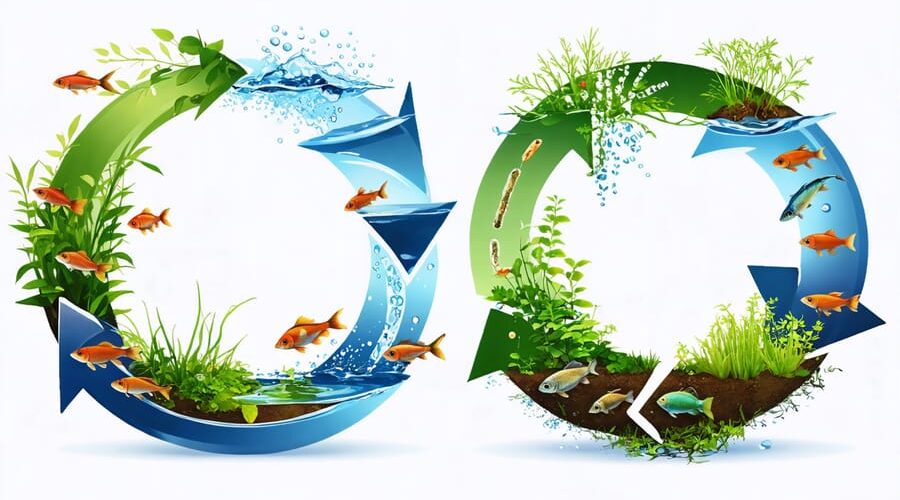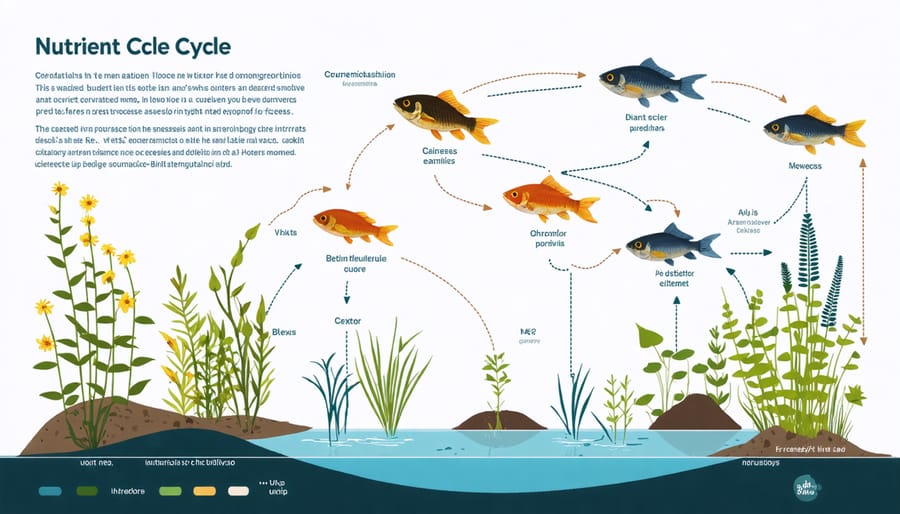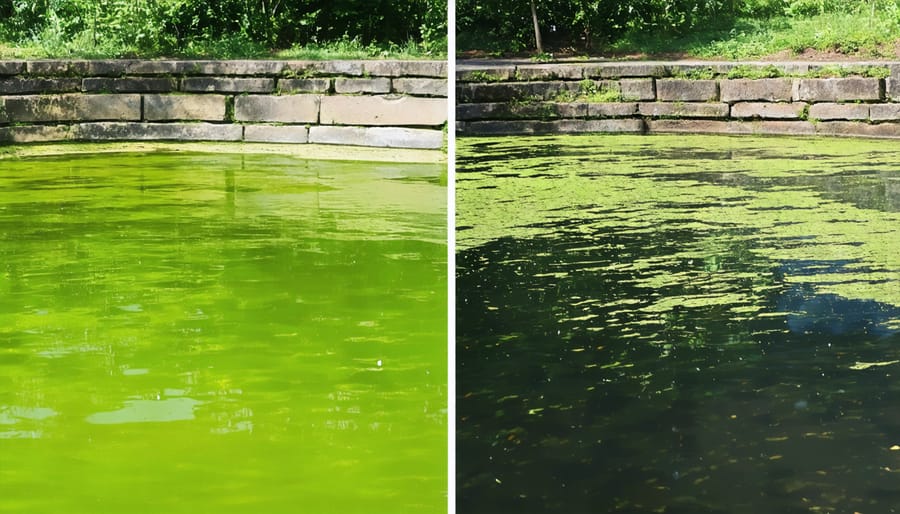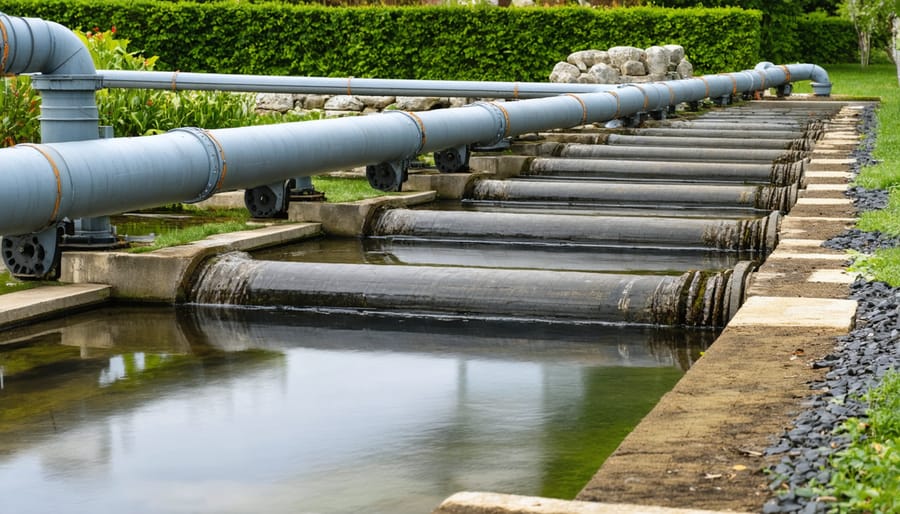
Why Your Water Garden’s Nutrient Levels Are Rising (And What It Means)
Nutrient surges in aquatic ecosystems transform peaceful ponds into challenging environments, often overwhelming even experienced water gardeners. When phosphates and nitrates spike, algae blooms explode, oxygen levels plummet, and fish struggle to thrive. Yet understanding and maintaining water garden balance doesn’t require a degree in chemistry. Natural processes, like decomposing plant matter, fish waste, and runoff from surrounding landscapes, constantly add nutrients to your pond. These inputs, while essential for healthy aquatic life, can quickly tip the scales from nurturing to problematic. By recognizing early warning signs – like cloudy water or excessive plant growth – and implementing timely solutions, you can protect your water garden’s delicate ecosystem. This balance between necessary nutrients and potential excess creates the foundation for a thriving, crystal-clear pond that brings joy throughout the seasons.
Natural Sources of Nutrient Increase
Decomposing Plant Matter
When leaves, twigs, and aquatic plants die off and sink to the bottom of your pond, they start a natural decomposition process that significantly impacts nutrient levels. As these plant materials break down, they release nutrients like nitrogen and phosphorus into the water. Think of it as nature’s own composting system, but underwater!
During fall, this process intensifies as trees shed their leaves, which often end up in your pond. While some leaf litter is natural and can benefit your pond’s ecosystem, too much can lead to excess nutrients. The decomposition process also uses up oxygen in the water, which can affect fish and other aquatic life.
Aquatic plants that die back seasonally contribute to this cycle as well. Their stems and leaves sink and decompose, adding to the nutrient load. In smaller ponds, this process happens more quickly and can have a more noticeable impact on water quality.
To maintain healthy nutrient levels, it’s important to remove fallen leaves regularly and trim dead plant material before it can sink and decompose. Using a pond net during fall can help catch leaves before they sink to the bottom.
Fish Waste and Feeding
Fish can significantly impact nutrient levels in your pond through their waste products and feeding habits. When fish digest food, they produce ammonia-rich waste that directly adds nutrients to the water. The more fish you have, and the more you feed them, the higher the nutrient load becomes.
Overfeeding is one of the biggest culprits in nutrient buildup. When you provide more food than your fish can eat in about 5 minutes, the excess sinks to the bottom and decomposes. This not only wastes food but also releases unnecessary nutrients into the water. During decomposition, uneaten food breaks down into compounds like phosphates and nitrates, which can fuel unwanted algae growth.
The size of your fish population matters too. A good rule of thumb is to maintain about 1 inch of fish per 10 gallons of water. Having too many fish in your pond creates an imbalance, leading to excessive waste production and stress on your filtration system.
To manage nutrient levels, feed your fish small portions 2-3 times daily during warm months, and reduce feeding during cooler weather when fish are less active. Using high-quality fish food also helps, as it’s more digestible and creates less waste.

External Nutrient Sources
Runoff and Rainfall
One of the most common ways nutrients enter your pond or water garden is through runoff and rainfall. When it rains, water flows across your lawn, garden, or nearby areas, picking up fertilizers, decomposing plant material, and other nutrient-rich substances along the way. These nutrients, particularly nitrogen and phosphorus, eventually make their way into your pond.
If you’ve recently fertilized your lawn or garden beds, a heavy rainfall can wash these nutrients directly into your water feature. Even natural debris like fallen leaves and grass clippings can contribute to nutrient loading when they’re carried by rainwater. In areas with slopes or uneven terrain, this process happens more quickly and intensely.
The seasonal changes in rainfall patterns also play a role. Spring rains often carry more nutrients due to increased fertilizer use and new plant growth, while autumn rains can wash in decomposing plant material. Understanding this natural cycle helps you anticipate and manage nutrient increases in your pond throughout the year, keeping your water garden healthy and balanced.
Fertilizer Impact
Garden fertilizers can dramatically affect your pond’s nutrient balance, often in ways you might not expect. When you feed your lawn or garden, rain and irrigation can wash these nutrients directly into your pond. Even if your garden isn’t right next to the water, fertilizers can travel surprising distances through soil and runoff.
The most common nutrients found in fertilizers are nitrogen and phosphorus, which act like superfood for aquatic plants and algae. While a small amount of these nutrients is necessary for a healthy pond ecosystem, too much can quickly lead to problems. You might notice your pond water turning green, developing an unpleasant smell, or becoming cloudy.
To protect your pond, consider using slow-release fertilizers and creating buffer zones of plants around the water’s edge. These natural barriers help filter out excess nutrients before they reach the pond. It’s also smart to avoid fertilizing when rain is forecast and to use only the amount your plants truly need. Remember, what’s good for your garden isn’t always good for your pond, so finding the right balance is key.

Signs of Nutrient Imbalance
Keeping a watchful eye on your water garden can help you spot signs of excess nutrients before they become a major problem. The most obvious indicator is algae growth – if you notice your pond water turning green or developing a film on the surface, that’s nature’s way of telling you there are too many nutrients present.
Look out for floating mats of stringy algae or thick, carpet-like growth along the bottom of your pond. Your aquatic plants might also give you clues – unusually rapid growth or plants that seem to be competing aggressively for space could indicate high nutrient levels.
Pay attention to your fish, too! If they’re gasping at the surface, especially in the early morning, it might mean oxygen levels are low due to excessive nutrient buildup. You might also notice an unpleasant smell coming from your pond, similar to rotting vegetation or swamp-like conditions.
Another tell-tale sign is cloudy or murky water that doesn’t clear up even after your filter has been running for a while. If you’re seeing leaves or organic debris accumulating faster than usual at the bottom of your pond, that’s contributing to the nutrient overload.
Keep an eye on your water features as well – pipes and fountains developing a slimy coating or requiring more frequent cleaning could indicate nutrient issues. Remember, catching these signs early makes it much easier to restore balance to your water garden’s ecosystem.
Managing Nutrient Levels
Natural Balance Methods
One of the most effective ways to control nutrient levels in your pond is through natural filtration methods using plants and beneficial bacteria. Water plants like water lilies, lotus, and rushes act as nature’s filters, absorbing excess nutrients directly from the water. These aquatic warriors not only create a beautiful display but also compete with algae for nutrients, helping maintain a healthy balance.
Floating plants such as water hyacinth and duckweed are particularly efficient at nutrient removal, thanks to their extensive root systems that dangle in the water. Place these plants strategically around your pond, covering about 50-60% of the surface area for optimal results.
Beneficial bacteria play an equally important role in this natural balancing act. These microscopic helpers break down organic matter and convert harmful ammonia into less problematic compounds. You can encourage beneficial bacteria growth by adding pond-specific bacterial supplements and ensuring good oxygen levels through proper circulation.
Creating planted zones or bog filters at the pond’s edge provides additional filtering power. These areas can house marginal plants like iris and cattails, which excel at nutrient absorption while adding visual interest to your water garden. Remember to maintain your plant population by removing dead foliage and dividing overcrowded plants annually to keep this natural system working efficiently.
Mechanical Solutions
One of the most effective ways to manage excess nutrients in your pond is through mechanical filtration and regular water changes. A good filtration system acts like a helpful assistant, removing floating debris and excess nutrients before they can cause problems. Consider installing a skimmer box or mechanical filter that catches leaves, twigs, and other organic matter before they decompose and release nutrients into the water.
Regular water changes are your best friend in nutrient management. Aim to replace about 10-15% of your pond water every two weeks, or more frequently if you notice water quality issues. When performing water changes, use a pond vacuum to remove settled debris from the bottom – this prevents nutrients from leaching back into the water.
For smaller ponds, you might want to try using filter socks or mats. These simple but effective tools trap fine particles and help reduce nutrient levels. Place them in areas with good water flow, like near your pump output or waterfall, for maximum effectiveness.
Remember to clean your filters regularly – at least once a month during peak growing season. A clogged filter can’t do its job properly and might even release trapped nutrients back into your pond. Keep a maintenance schedule and stick to it – your pond will thank you with clearer, healthier water.

Managing nutrients in your water garden is crucial for maintaining a healthy, vibrant ecosystem. We’ve explored how nutrients enter your pond through various sources, from fish waste to fallen leaves, and learned about the warning signs of excess nutrients like algae blooms and murky water. Remember that prevention is always easier than cure – regular maintenance, proper filtration, and careful feeding habits go a long way in keeping nutrient levels balanced. By implementing the strategies we’ve discussed, such as adding beneficial plants, maintaining proper fish populations, and using appropriate filtration systems, you can create a thriving pond environment that’s both beautiful and sustainable. Stay proactive in your pond care routine, and you’ll be rewarded with crystal-clear water and happy, healthy aquatic life for years to come.
